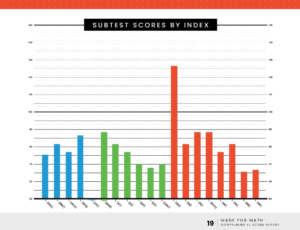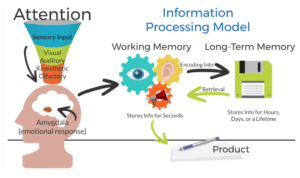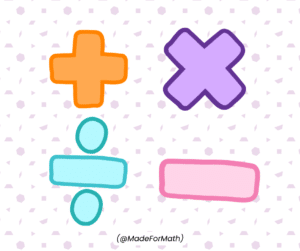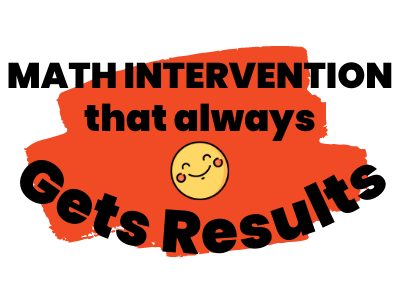6 Surprising Ways Dyslexia Affects Math and How to Help
Does your child have dyslexia? Do they stumble through math problems, straining to find the difference between multiplication and addition symbols? Or perhaps they get lost in the directionality of math and position of numbers. Many people believe that dyslexia is only a language-based issue, however, Dr. David Geary finds that about 50% of those with dyslexia also struggle with mathematics. We’ll be covering the processes needed to be successful in math and show you how dyslexia affects math.
Signs They Need Help With Math
Here are some things we see with students who might need a little extra help because their dyslexia affects math skills. Hover over or tap the boxes to see the signs they need help with math.











Is it dyscalculia? Or rather… is dyslexia affecting math?
Between 5-8% of school-age children have a math learning disability called dyscalculia, which is about one or two kids per classroom. At MFM, we sometimes see dyscalculia get overdiagnosed and this could be for a number of reasons. They may have taken too long to complete a section of testing or even have a comorbid disorder, like dyslexia.
When looking at testing, students with dyscalculia score very low on almost everything. There are strengths, however, very little falls within the average category. The student below has dyscalculic tendencies and their score rarely falls between 90 and 110.

On the other hand, a student with dyslexia would score more like this:

Their scores are approaching average and aren’t as low as a dyscalculic student in many categories. The outlier in the above image is Visual and Spatial skills, this is where dyslexic students often score well. They are capable of visualizing and seeing the big picture in their heads.
There are also a number of co-occurring conditions that are likely to show up with dyslexia. Including, but not limited to:
- Dyscalculia
- Dyspraxia
- ADHD
- Sensory Processing
- Autism
- Math Anxiety
Dyslexia definitions have changed over time. In 1988, there was a USA definition that included mathematics as an issue! (Mathematics for Dyslexics and Dyscalculics) Many people believe that it’s only a language-based problem but dyslexia affects math.
Processes Needed for Math
There are several processes needed to be successful in math, they include:
- Language and Verbal Retrieval Skills
- Working Memory Skills
- Speed of Working
- Executive Functioning Skills
- Visual-Spatial Skills
Language and Verbal Retrieval Skills
When you have a child with dyslexia, they often learn to read by tying a word to an image. They can say the word pencil and clearly visualize a pencil.

However, students with dyslexia tend to skip over words like “the, of, and, is” because they cannot visually see them. This student will run into issues when they are faced with math. For someone with dyslexia, the word “of” has no meaning to them. When we ask them to take ½ of 4, they are lost! In their mind that tiny little word is not important. You have to explain to them that “of” has many meanings and in math it is important.
Working Memory Skills
Working memory is the small amount of information that can be held temporarily to complete tasks.
Sian Beilock and her team studied the brain through MRI Imaging and found that math facts are held in the working memory part of the brain. (Beilock, 2001 Ramirez et al 2013)
The brain retrieves the information in the long-term and holds it in the working memory. Where the brain retrieves those math facts can be different based on what they need to bring back. For example, addition and subtraction is held in the numeracy part of the brain, however, multiplication and division is in the language part of the brain.
This tells us that how the brain makes sense of mathematical thinking changes the way in which it is stored.
This matters because the information is stored differently and a student might be spending a lot of their working memory trying to retrieve those math facts, especially multiplication and division.
With working memory we have an “inner eye” where visual information is used. This inner eye is used for understanding mental math and magnitude (how big or small a number is). Many students will look up at the sky or the ground when working and this tells us they have a very strong visual memory.
We also have the “inner voice” which is what is used for finding and using math facts and naming numbers.
For example, a child may be thinking of a number while struggling to write it down because they have a weak inner voice.
Tip: This is why it’s so important to tie math facts to a visual when teaching students who are dyslexic. Visual meaning not just math symbols, but clay or models to really show them what you are trying to teach.
Speed of Working
Is your child completely overwhelmed when they are faced with a timed test?
Performing under pressure is stressful! Dyslexic students take 50% longer to complete or attempt stopping at a task (Chinn, 1995).
Our CEO Adrianne believes this is because “…dyslexic students are so visual that it takes them a long time to translate something into a symbolic way onto paper and they are willing to keep trying and trying.”
The speed of timed tests induces anxiety and slows down working memory. Their normal ability to retrieve information and use it is gone.
Pictured below is the Information Processing Model which shows how the brain learns.

There are various spots where the learning can break down and get lost. Timed tests are anxiety-inducing for students and the Amygdala can shut down the ability to learn. No more working memory to retrieve information from the long term.
This “slowness” can also cause a misdiagnosis of dyscalculia because of the timed factors that many screeners have.
Executive Functioning Skills
Executive Functioning is the ability to carry out a plan or understand the issue or problem that needs to be done. It is the sequence of steps needed to complete a task and also the control of your emotions, mind, and senses to do so. For example, cleaning your room or doing your math homework.
Both of these tasks take time to complete and have many steps to the process. For example, homework: Did they understand the homework given? Do they remember to check for homework when they get home? Did they put their name on it? Do they remember to put their papers back into their backpack for school the next day? Did they remember to turn it in for credit?
These questions aren’t even half of all of the steps that it takes to complete a math homework assignment. A student with poor executive functioning skills will find all of these little tasks extremely hard to remember and difficult to complete.
Watch this 6-minute video on executive function and math barriers, here.
Tips for Executive Function!
Cut ALL the Clutter
- Worksheets–1 or 2 problems to a page so they have space to work.
- Environment–Minimal distractions, cooking dinner, siblings, loud videos, etc. are all distracting. Quiet and calm environments will help.
- Language–When you are talking about math use as minimal language as possible.
- Routines–The brain loves patterns. Completing homework at the same time and place, homework is located in the same spot, and starting homework the same way can help.
Sequencing Help
- Near-point reference–something on their desk they can refer back to or writing down the steps for them.
- Short and Snappy
- Create a visual
- Add movement
- Give them room to work–Large graphing paper to keep problems in order.
Check out this example of a near-point reference for long division.
Visual-Spatial
This is a strength for a lot of our students with dyslexia, however, there are some mico issues within that can cause problems. These are direction and position, vision difficulties, and spatial awareness.
Direction and Position–Can your child tie their shoes? Do they mix up their left and right?
This quote from Leslie Templeton sums it up perfectly.
“My dyslexia makes it difficult to understand sequencing and directionality. I don’t know left/right and up/down. These take me a second to process; also now/then, here/there, before/after, and so on really confuse me.” -Leslie Templeton
Directionality is important in mathematics. Which shape is above the star? Which shape is before the square?
Practicing these skills at a young age is vital to learning harder math later on in life. Even in addition, there are steps where you need to know the direction to complete the problem. You start on the left and identify the operation and then shift all the way to the right and work left by place value.
These students are also learning to read which is taught from left to right. Then they are given math which throws all established patterns out the window and this can be confusing to navigate.
Tips for directionality:
- Try using a vertical number line instead of a horizontal one for a more natural understanding of numbers getting bigger and smaller. This will help students better understand negative numbers.
- Gross Motor–Draw numbers on their back and have them write down what number they feel to help with number reversal. Practicing columns and rows while using numbers like 1st, 2nd, 3rd. Using a wrapping paper tube for a number line so they can feel and count up and down.
The addition, multiplication, and division symbols all look similar to a student who is skimming.

They can easily be mistaken for each other, which is why slowing down is so important. Circling the order of operations or even shaping the symbols out of clay can help your student with slowing down.
Students with dyslexia are so visual they can often spin objects in their minds and see them from multiple angles. Number reversals are common and this is why ‘6’ and ‘9’ are so easily mixed up for some students. They might also think ‘6’ but write ‘9’ on their paper–which is why you have to explicitly teach them to visually see the difference. (Drawing a number on their back also helps with this)
Check out this simple trick for number reversals, here.
Tips for Vision Difficulties:
- Circling the operation–even for the older kids.
- Minimal problems on the page–1 or 2 problems at most. Visual space to work through the problems is vital.
Spatial Awareness
A lot of our students have bad alignment issues and they struggle with not knowing where to start. This might look like their pencil hovering over the paper, unable to make the first steps. The math can also go wrong because they couldn’t quite line the numbers up correctly. Graph paper is a great tool to help students line up their equations.
Tips for Spatial Awareness:
- Bitpaper–Grid size is adjustable, endless paper to scroll down for more work.
- Bigger graphs the better
Multisensory Math
Your child is gifted with a visual spatial mind which means they think in pictures and 3D objects. It is extremely helpful for them to do things with the CRA Method and Multisensory Math. C-Concrete–Things you can touch in your hands R-Representational–Things you can draw A-Abstract–Just numbers Unfortunately, abstract is where most of our schooling takes place especially in middle and high school. We are really lacking the concrete and representational learning within our school system. Adding movement and manipulaives to your childs learning can astronomically help them understand and remember topics they’ve struggled with. Check out this 1-minute video on the CRA Method. The CRA Method and Multisensory Math is important for all learners, but it is essential for learners with dyslexia, autism, ADHD, dyscalculia, and more. It makes a huge difference in creating a foundation for learning that they can build upon. Dyslexia affects math in more ways than we realize. If you suspect your child may need math help, look no further!Resources
If you are looking for multisensory math instruction, we provide one-on-one sessions with students using the CRA Method and manipulatives! Every lesson is unique to the child and keeps in mind their special interests to help inspire their math learning. We speciaize in working with children with dyslexia, autism, dyscalculia, math anxiety, ADHD, and SLD. Interested in learning more about our multisensory math intervention? Check out a demo class, here. More of a reader? Check out the 12 math books that we love, here. Or check out one of our favorite books, Mathematics for Dyslexics and Dyscalculics by Steve Chinn–which can be purchased through our affiliate link, here.Multisensory Math Is Fundamentally Different
Check Out our Solo Lessons to See How
We are teachers who provide specialized multisensory math intervention to students with dyslexia, dyscalculia, autism, ADHD, and more. We’re tired of the “one-size-fits-all” attitude toward education and our goal is to provide a fun and safe space for children to learn at their own pace.
What are we offering?
- Customized Learning for your child
- One-to-one sessions
- 25 or 55 minute sessions
- Recordings of each session so you can see your child interacting with the method
- All multisensory math materials mailed to your home
- No contract, cancel anytime
- A FUN environment where your child can thrive
Multisensory Math is appropriate for all learners but is essential for those with dyslexia and dyscalculia.
Is multisensory math right for you and your family?
MFM Authors

Jennie Miller
Marketing Assistant
is our Marketing Assistant and content creator here at Made for Math. Jennie loves being part of a company that is working to make mathematics accessible to children with dyscalculia.

